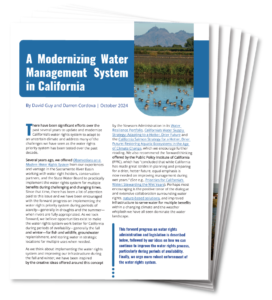
 By David Guy, NCWA and Darren Cordova, MBK Engineers
By David Guy, NCWA and Darren Cordova, MBK Engineers
There have been significant efforts over the past several years to update and modernize California’s water rights system to adapt to an uncertain climate and address many of the challenges we have seen as the water rights priority system has been tested over the past decade.
Several years ago, we offered Observations on a Modern Water Rights System from our experiences and vantage in the Sacramento River Basin working with water right holders, conservation partners, and the State Water Board to practically implement the water rights system for multiple benefits during challenging and changing times. Since that time, we have been encouraged with the forward progress on implementing the water rights priority system during periods of scarcity–generally in droughts and the summer–when rivers are fully appropriated. As we look forward, we believe opportunities exist to make the water rights system work better for California during periods of availability–generally the fall and winter–for fish and wildlife, groundwater replenishment, and storing water in strategic locations for multiple uses when needed.
As we think about implementing the water rights system and improving our infrastructure during the fall and winter, we have been inspired by the creative ideas offered around this concept by the Newsom Administration in its Water Resilience Portfolio, California’s Water Supply Strategy: Adapting to a Hotter, Drier Future and the California Salmon Strategy for a Hotter, Drier Future: Restoring Aquatic Ecosystems in the Age of Climate Change, which we encourage further reading. We also recommend the forward thinking offered by the Public Policy Institute of California (PPIC), which has “concluded that while California has made great strides in planning and preparing for a drier, hotter future, equal emphasis is now needed on improving management during wet years.” (See e.g., Priorities for California’s Water: Stewarding the Wet Years). Perhaps most encouraging is the positive tenor of the dialogue and extensive collaboration surrounding water rights, nature-based solutions, and improved infrastructure to serve water for multiple benefits within a changing climate and the weather whiplash we have all seen dominate the water landscape.
This forward progress on water rights administration and legislation is described below, followed by our ideas on how we can continue to improve the water rights process, particularly during periods of availability. Finally, we urge more robust enforcement of the water rights system.
Click to continue reading full document.




